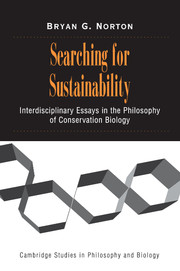Book contents
- Frontmatter
- Contents
- Searching for Sustainability
- General Introduction: An Interdisciplinary Experiment
- I PRAGMATISM AS AN ENVIRONMENTAL PHILOSOPHY
- II SCIENCE, POLICY, AND POLICY SCIENCE
- 6 What Is a Conservation Biologist?
- 7 Biological Resources and Endangered Species: History, Values, and Policy
- 8 Leopold as Practical Moralist and Pragmatic Policy Analyst
- 9 Improving Ecological Communication: The Role of Ecologists in Environmental Policy Formation
- III ECONOMICS AND ENVIRONMENTAL SUSTAINABILITY
- IV SCALING SUSTAINABILITY: ECOLOGY AS IF HUMANS MATTERED
- V SOME ELEMENTS OF A PHILOSOPHY OF SUSTAINABLE LIVING
- VI VALUING SUSTAINABILITY: TOWARD A MORE COMPREHENSIVE APPROACH TO ENVIRONMENTAL EVALUATION
- Index
- References
7 - Biological Resources and Endangered Species: History, Values, and Policy
Published online by Cambridge University Press: 21 January 2010
- Frontmatter
- Contents
- Searching for Sustainability
- General Introduction: An Interdisciplinary Experiment
- I PRAGMATISM AS AN ENVIRONMENTAL PHILOSOPHY
- II SCIENCE, POLICY, AND POLICY SCIENCE
- 6 What Is a Conservation Biologist?
- 7 Biological Resources and Endangered Species: History, Values, and Policy
- 8 Leopold as Practical Moralist and Pragmatic Policy Analyst
- 9 Improving Ecological Communication: The Role of Ecologists in Environmental Policy Formation
- III ECONOMICS AND ENVIRONMENTAL SUSTAINABILITY
- IV SCALING SUSTAINABILITY: ECOLOGY AS IF HUMANS MATTERED
- V SOME ELEMENTS OF A PHILOSOPHY OF SUSTAINABLE LIVING
- VI VALUING SUSTAINABILITY: TOWARD A MORE COMPREHENSIVE APPROACH TO ENVIRONMENTAL EVALUATION
- Index
- References
Summary
This chapter examines the role of the U.S. Endangered Species Act (ESA) of 1973 in the broader context of protecting biological resources by considering its historical, valuational, and policy aspects. Three historical “phases” of policy thinking on the environment are identified: single-species protection (1800–1980), biodiversity (1980–1988), and substainability of ecosystem health (1988–present). The ESA is representative of the thought behind the first phase and, in this sense, is anachronistic; but the protection of biological resources is supported by many important human values. So the question remains whether the ESA is the best approach to protecting biological resources, given that current thinking goes beyond individual species. It is argued that, given our state of knowledge and managerial abilities, the ESA remains the most viable policy tool for protecting biological resources, but it should be applied so as to improve managerial knowledge and encourage more eco-systematic approaches.
The protection of biological diversity has become a central goal of environmental protectionism. On one level, this goal is noncontroversial, a motherhood-and-apple-pie issue – there are no advocates for species destruction or for accelerating species loss. Nevertheless, there remain important differences regarding how much we should do, what we should do, and even what is of ultimate value. Because the protection of biodiversity – no matter how strongly supported publicly – will certainly proceed within a context of uncertainty, this paper advocates an adaptive management approach to protecting biological resources.
- Type
- Chapter
- Information
- Searching for SustainabilityInterdisciplinary Essays in the Philosophy of Conservation Biology, pp. 110 - 129Publisher: Cambridge University PressPrint publication year: 2002
References
- 1
- Cited by



